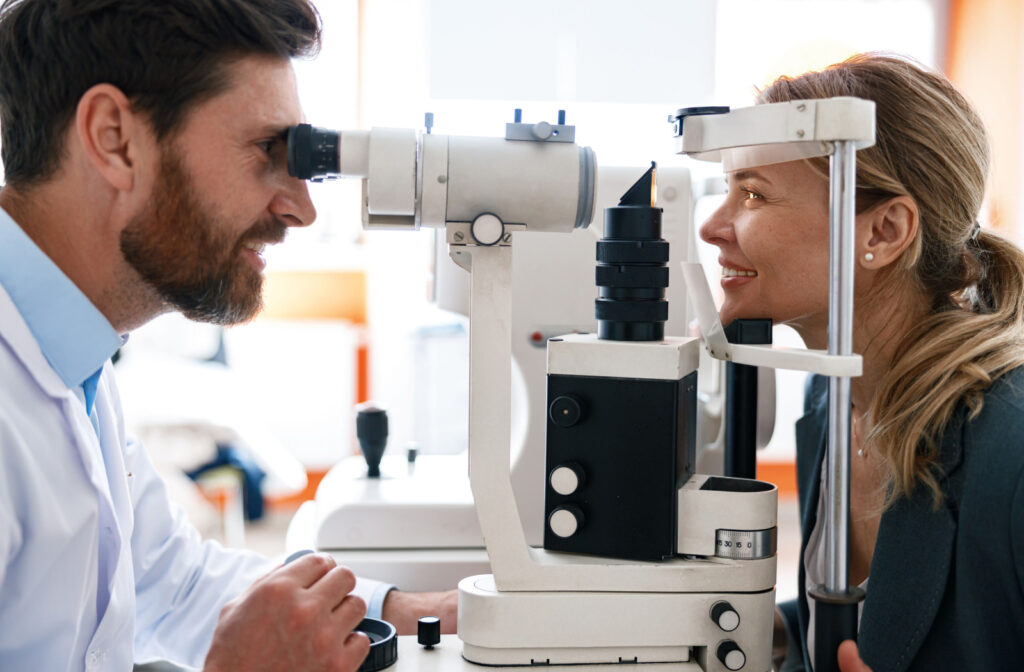If you’ve been delaying your next eye exam because you’re unsure how long it will take, you’re not alone. Eye exams are crucial for supporting your eye health, but the last thing you want is to sit in the optometrist’s office wondering if you’ll be late for your next meeting or worried about getting your kids back to class.
Typically, a comprehensive eye exam takes around 30 to 40 minutes, depending on your medical history or eye concerns. Contact lens fittings can take approximately 15 minutes for an experienced wearer but may take up to an hour for someone new to contacts.
At Envision Eye Care, we conduct a thorough exam, but we respect your time so you can get back to your busy schedule with clearer vision.
What to Expect
Generally, routine eye exams usually take about 30 to 40 minutes. But if this is your first time seeing a particular eye doctor or you have an eye condition or vision problem, it may take longer.
Eye exams include a series of tests to measure your visual acuity and overall eye health. Before the exam, your optometrist will ask about your medical and family history of eye conditions.
Visual Acuity Test
20/20 vision is a term that expresses visual acuity. A visual acuity test evaluates how well you can see at a standard distance. Using a Snellen letter chart, you’ll be asked to recite the letters of various sizes with a range of lenses to determine the clarity of your vision.
Preliminary Tests
To assess your eye health, your optometrist will perform a series of tests to determine your eye movements and response to light. They’ll measure your depth perception, color vision, and peripheral vision to detect early signs of eye conditions. These tests include internal eye pressure tests to screen for glaucoma, taking images of your retina and ocular nerve to look for signs of retinal diseases, and visual field testing to look for blind spots that may indicate eye diseases.
Keratometry & Corneal Topography
If you’re a contact lens wearer, keratometry and corneal topography measure the curve of your cornea and the diameter of your iris to fit you for correctly sized contact lenses.
Refraction
Refractive errors, such as nearsightedness, farsightedness, and astigmatism, are the primary causes of blurry and distorted vision. A refraction test measures the strength of the prescription you need to correct your vision.
Types of Exams
Most think of eye exams as simple vision tests, but comprehensive eye exams are individualized to each person to test their ocular health and vision.
Comprehensive Eye Exams
Comprehensive eye exams are crucial for maintaining vision and overall eye health. By scheduling routine check-ups, potential eye conditions can be uncovered early on, preventing them from progressing into more serious problems. These exams are especially vital because many eye diseases, like glaucoma and macular degeneration, have no noticeable symptoms in the early stages.
Eye exams can also reveal underlying health issues such as diabetes and hypertension.
Contact Lens Exams
A contact lens exam can be added to your comprehensive eye exam but doesn’t replace it. Contact lens exams are for those who wear or want to wear contact lenses. Unlike routine eye exams, contact lens exams focus on finding the right fit and maintaining your overall eye health with long-term contact lens use. These exams should be done annually to ensure proper fit and performance of your contacts.
Pediatric Eye Exams

Pediatric eye exams are for children of all ages. We recommend that children have their first eye exam between 6 and 9 months, again between 12 and 36 months, and a third between 3 and 5 years old.
In infancy, vision alignment issues are difficult for parents to detect, but an experienced optometrist can identify signs of amblyopia (lazy eye) or strabismus (crossed eyes) and begin treatment.
Children’s eye exams take about 30 to 45 minutes, and your eye doctor will also look for common childhood vision issues like nearsightedness, farsightedness, astigmatism, and color blindness.
Diabetic Eye Exams
Diabetes increases your risk of developing diabetic retinopathy, glaucoma, and cataracts. Annual diabetic eye exams are critical for preserving your vision. You should visit your optometrist immediately if you experience:
- Flashes and floaters in your vision
- Blind spots
- Fluctuating vision
- Blurry vision
- Issues with color vision
Eye Exam Technology
Eye exams are now more precise than ever, thanks to the technological advancements in optometry.
Optical Coherence Tomography (OCT)
OCT is a noninvasive imaging technology that uses light waves to capture detailed images of the retina. This technology provides an accurate and precise assessment of the retina, macula, and optic nerve, which helps detect eye diseases like glaucoma, macular degeneration, and retinal detachments.
Visual Field Testing
Also known as perimetry, a visual field test measures peripheral vision. This technology helps detect and diagnose conditions like glaucoma or brain lesions by mapping your whole field of vision and identifying visual blind spots. The procedure allows your eye doctor to assess the quality of surrounding vision and determine areas where the vision has been affected.
This test can help detect eye and brain disorders that can lead to vision loss if not treated promptly.
Make Time for Your Eye Exam
Taking an hour of your day for an eye exam is crucial for supporting your whole-body health and well-being. Whether you take a long lunch break, let your kids miss their first class, or visit on a weekend, your vision and eye health are worth the time. Schedule an appointment at Envision Eye Care for your vision care needs.



